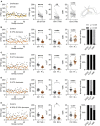Variance analysis as a method to predict the locus of plasticity at populations of non-uniform synapses
- PMID: 37528963
- PMCID: PMC10388551
- DOI: 10.3389/fncel.2023.1232541
Variance analysis as a method to predict the locus of plasticity at populations of non-uniform synapses
Abstract
Our knowledge on synaptic transmission in the central nervous system has often been obtained by evoking synaptic responses to populations of synapses. Analysis of the variance in synaptic responses can be applied as a method to predict whether a change in synaptic responses is a consequence of altered presynaptic neurotransmitter release or postsynaptic receptors. However, variance analysis is based on binomial statistics, which assumes that synapses are uniform. In reality, synapses are far from uniform, which questions the reliability of variance analysis when applying this method to populations of synapses. To address this, we used an in silico model for evoked synaptic responses and compared variance analysis outcomes between populations of uniform versus non-uniform synapses. This simulation revealed that variance analysis produces similar results irrespectively of the grade of uniformity of synapses. We put this variance analysis to the test with an electrophysiology experiment using a model system for which the loci of plasticity are well established: the effect of amyloid-β on synapses. Variance analysis correctly predicted that postsynaptically produced amyloid-β triggered predominantly a loss of synapses and a minor reduction of postsynaptic currents in remaining synapses with little effect on presynaptic release probability. We propose that variance analysis can be reliably used to predict the locus of synaptic changes for populations of non-uniform synapses.
Keywords: amyloid–beta; excitatory postsynaptic current (EPSC); hippocampus; synapse; uniformity; variance.
Copyright © 2023 Lumeij, van Huijstee, Cappaert and Kessels.
Conflict of interest statement
The authors declare that the research was conducted in the absence of any commercial or financial relationships that could be construed as a potential conflict of interest.
Figures





Similar articles
-
Quantal analysis of EPSCs recorded from small numbers of synapses in hippocampal cultures.J Neurophysiol. 1995 Mar;73(3):1145-56. doi: 10.1152/jn.1995.73.3.1145. J Neurophysiol. 1995. PMID: 7608761
-
Variance analysis as a tool to predict the mechanism underlying synaptic plasticity.J Neurosci Methods. 2020 Feb 1;331:108526. doi: 10.1016/j.jneumeth.2019.108526. Epub 2019 Nov 19. J Neurosci Methods. 2020. PMID: 31756397
-
Locus of frequency-dependent depression identified with multiple-probability fluctuation analysis at rat climbing fibre-Purkinje cell synapses.J Physiol. 1998 Aug 1;510 ( Pt 3)(Pt 3):881-902. doi: 10.1111/j.1469-7793.1998.881bj.x. J Physiol. 1998. PMID: 9660900 Free PMC article.
-
Role of adenosine in the control of homosynaptic plasticity in striatal excitatory synapses.J Integr Neurosci. 2005 Dec;4(4):445-64. doi: 10.1142/s0219635205000987. J Integr Neurosci. 2005. PMID: 16385640 Review.
-
Molecular mechanisms that underlie structural and functional changes at the postsynaptic membrane during synaptic plasticity.Prog Neurobiol. 1998 Aug;55(6):611-40. doi: 10.1016/s0301-0082(98)00026-4. Prog Neurobiol. 1998. PMID: 9670221 Review.
Cited by
-
Amyloid-β-Driven Synaptic Deficits Are Mediated by Synaptic Removal of GluA3-Containing AMPA Receptors.J Neurosci. 2025 Feb 26;45(9):e0393242024. doi: 10.1523/JNEUROSCI.0393-24.2024. J Neurosci. 2025. PMID: 39779375 Free PMC article.
References
LinkOut - more resources
Full Text Sources

